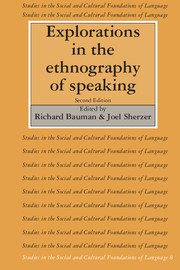Book contents
- Frontmatter
- Contents
- INTRODUCTION TO THE SECOND EDITION
- I PREFACE AND INTRODUCTION
- II COMMUNITIES AND RESOURCES FOR PERFORMANCE
- III COMMUNITY GROUND RULES FOR PERFORMANCE
- IV SPEECH ACTS, EVENTS, AND SITUATIONS
- V THE SHAPING OF ARTISTIC STRUCTURES IN PERFORMANCE
- Introduction
- 14 Correlates of Cree Narrative Performance
- 15 An Analysis of the Course of a Joke's Telling in Conversation
- 16 When Words Become Deeds: An Analysis of Three Iroquois Longhouse Speech Events
- 17 The Ethnographic Context of Some Traditional Mayan Speech Genres
- 18 To Speak with a Heated Heart: Chamula Canons of Style and Good Performance
- VI TOWARD AN ETHNOLOGY OF SPEAKING
- Notes
- References
- Index of names
15 - An Analysis of the Course of a Joke's Telling in Conversation
Published online by Cambridge University Press: 05 June 2012
- Frontmatter
- Contents
- INTRODUCTION TO THE SECOND EDITION
- I PREFACE AND INTRODUCTION
- II COMMUNITIES AND RESOURCES FOR PERFORMANCE
- III COMMUNITY GROUND RULES FOR PERFORMANCE
- IV SPEECH ACTS, EVENTS, AND SITUATIONS
- V THE SHAPING OF ARTISTIC STRUCTURES IN PERFORMANCE
- Introduction
- 14 Correlates of Cree Narrative Performance
- 15 An Analysis of the Course of a Joke's Telling in Conversation
- 16 When Words Become Deeds: An Analysis of Three Iroquois Longhouse Speech Events
- 17 The Ethnographic Context of Some Traditional Mayan Speech Genres
- 18 To Speak with a Heated Heart: Chamula Canons of Style and Good Performance
- VI TOWARD AN ETHNOLOGY OF SPEAKING
- Notes
- References
- Index of names
Summary
0.0 In this paper we examine the sequential organization of the telling of a dirty joke in conversation. For the organization of the joke and also of its telling we find that there is a single most decisive feature: the joke is built in the form of a story. The decisiveness of that feature involves the fact that, there being means for sequentially organizing the telling of a story in conversation, the sequential organization of the telling of this joke's being built in the form of a story is largely given by those means. This telling is composed, as for stories, of three serially ordered and adjacently placed types of sequences which we call the preface, the telling, and the response sequences. We shall proceed by considering each of them in turn, intending that the adequacy of such a characterization as is developed in terms of these types for these materials will provide support to our proposal that the joke's construction in the form of a story is indeed its decisive feature.
0.1 In what follows we shall largely be concerned to subject the utterances of the fragment, of which we present a transcription at the close of this section, to analysis in terms of how they figure in the three types of sequences we have proposed to constitute organizational parts of the telling. In this endeavor one recurrent theme may be extracted for introductory comment.
- Type
- Chapter
- Information
- Explorations in the Ethnography of Speaking , pp. 337 - 353Publisher: Cambridge University PressPrint publication year: 1989
- 45
- Cited by



